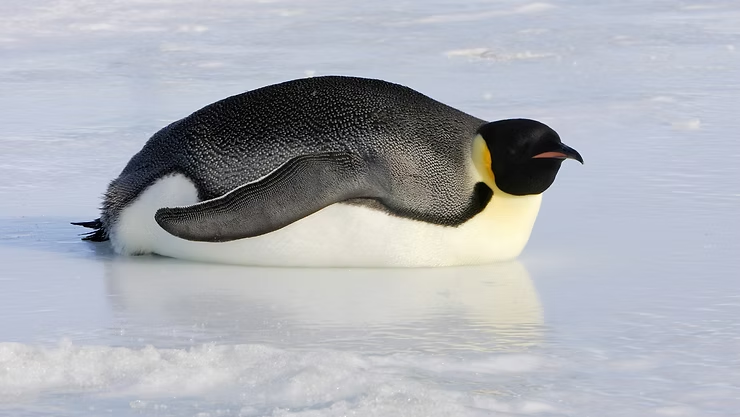Top 10 Fascinating Facts About Emperor Penguins
Emperor penguins are among the most remarkable creatures on Earth. As the tallest and heaviest of all penguin species, they thrive in one of the planet’s harshest environments. From their ability to withstand brutal cold to their incredible diving skills, these penguins are true masters of survival. Let’s explore their extraordinary characteristics and the challenges they face in the modern world.
The Largest Penguin Species
Emperor penguins can reach up to 4 feet in height and weigh around 80–90 pounds. Their striking black and white plumage, accented with yellow markings on the neck and head, helps them blend into the icy landscape. Dense layers of feathers and insulating blubber enable them to endure temperatures as low as -76°F during the Antarctic winter.
Unique Physical Adaptations
- A thick layer of blubber provides insulation and energy reserves during fasting periods.
- Flippers are shaped for powerful swimming and deep diving.
- Specialized feathers keep their skin dry and trap warmth close to the body.
- Distinct yellow patches on the neck and head add color to their otherwise monochrome plumage.
Surviving the Extreme Cold
Emperor penguins have evolved behaviors that allow them to withstand freezing temperatures and fierce winds. They huddle in large groups to conserve heat, taking turns in the warmer center. Their circulatory system reduces heat loss, while oil from their preen gland waterproofs feathers, keeping them dry in icy conditions.
Incredible Diving Abilities
These penguins are exceptional divers, reaching depths of over 1,800 feet in search of food. They can stay underwater for up to 20 minutes, aided by their streamlined bodies and efficient oxygen use. Their underwater vision allows them to track fast-moving prey such as fish, squid, and krill with remarkable precision.
Mating Rituals and Family Life
During breeding season, emperor penguins form monogamous pairs. Courtship includes bowing, vocal calls, and synchronized movements. After mating, the female lays a single egg, which the male carefully incubates on his feet beneath a flap of skin. Males fast for weeks in the bitter cold while protecting the egg, and once it hatches, both parents take turns feeding and raising the chick.
The Longest Penguin Migration
Every year, emperor penguins travel hundreds of miles across Antarctica to reach breeding grounds. Parents may trek up to 75 miles to gather food for their chicks, enduring extreme weather and icy terrain. This migration is vital to their survival, ensuring access to both safe nesting sites and reliable feeding areas.
Communication and Social Bonds
Emperor penguins use vocal calls, body postures, and visual displays to communicate. Each penguin has a distinct call that helps mates and chicks recognize one another among thousands in a colony. Their social behaviors, including cooperative huddling, are essential for survival in harsh environments.
Diet and Feeding Habits
- Diet includes fish, krill, and squid.
- Streamlined bodies and strong flippers make them efficient hunters.
- They rely on excellent underwater vision to locate prey in dim light.
Threats to Their Population
Climate change and melting sea ice pose serious threats to emperor penguins. With less ice available for breeding and hunting, chick survival rates decline. Overfishing of key food sources like krill further impacts their food supply. Studies show population declines in several colonies, especially near the Antarctic Peninsula.
Conservation Efforts
The International Union for Conservation of Nature (IUCN) lists emperor penguins as near threatened. Conservation measures focus on reducing carbon emissions, protecting Antarctic habitats, and regulating fishing practices. Preserving sea ice and curbing global warming are essential to their long-term survival.
In Conclusion
Emperor penguins are powerful symbols of resilience, adaptation, and family commitment. From their deep dives to their long migrations, they embody the harsh beauty of Antarctica. Protecting these penguins means safeguarding not only a species but also the fragile ecosystems they depend on. By understanding and supporting conservation efforts, we can help ensure emperor penguins continue to thrive for generations to come.
Frequently Asked Questions
How tall can emperor penguins grow?
They can reach up to 4 feet tall, making them the largest penguin species.
How cold can emperor penguins survive?
They can withstand temperatures as low as -76°F during Antarctic winters.
How long can emperor penguins hold their breath?
They can dive and remain underwater for up to 20 minutes.
What do emperor penguins eat?
Their diet consists mainly of fish, krill, and squid.
What are the main threats to emperor penguins?
Climate change, sea ice loss, and overfishing threaten their survival.

